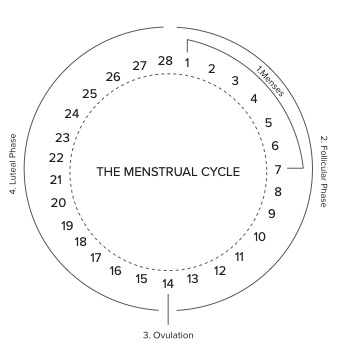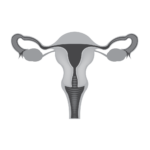Fact-checked by Kimberly Luedecke, RN, BSN, CFCP
As women — and as men — we’re not always taught the intricacies of how the female body works and what each signal the body gives to us means. Here, we want to rectify that, so you can be empowered to understand and advocate for your body. Let’s take a look at the beauty of the female reproductive system.
The basics:
The menstrual cycle begins with the first day of bleeding (menstruation) and ends with the day before the beginning of the next menstruation; throughout a cycle at varying times and under the influence of various hormones, the body bleeds, produces cervical mucus and ovulates. The average length of the menstrual cycle is approximately 28 days, although at some point, most people who menstruate will experience menstrual cycles that last anywhere from 21 to 40 days. The body is oriented towards pregnancy, and the menstrual cycle facilitates the possibility of a woman becoming pregnant.
Let’s take a look at what happens during the four phases of the menstrual cycle. The four phases of the menstrual cycle include:
1. Follicular Phase and Menses
Preovulatory
Main hormones:
- Follicle stimulating hormone (FSH) — Produced by the pituitary gland, this hormone stimulates the development of an egg within the ovary.
- Estrogen — Produced by a developing follicle, this main preovulatory hormone stimulates the production of cervical mucus from the cervix, so sperm can travel through the cervix to meet with the egg to create an embryo.
The menstrual flow or period — the days when a woman sheds her uterine lining cells and they are dispelled from the uterus through the vagina — usually lasts from three to seven days, with the first few days being heavier in flow than the last few days. This shedding of the uterine lining causes the lining to become very thin. After menstruation, due to the increase of the estrogen hormone, the uterine lining begins to grow and develop again.
What’s happening with the mucus cycle and fertility: During menses, a woman may be fertile, if cervical mucus is present. A woman can assess cervical mucus on the light days of bleeding to determine if she is fertile and if she will have an early ovulation that cycle. It is too difficult to assess cervical mucus on the heavy and moderate days of bleeding, so it is recommended to consider those days as fertile, in case the woman has an early ovulation.
2. Continuation of Follicular Phase
Preovulatory
Main hormones:
- Follicle stimulating hormone (FSH) — Produced by the pituitary gland, this hormone stimulates the development of an egg within the ovary.
- Estrogen — Produced by a developing follicle, this main preovulatory hormone stimulates the production of cervical mucus from the cervix, so sperm can travel through the cervix to meet with the egg to create an embryo.
This phase overlaps with menses, starting with the first day of menstruation and continuing until ovulation. Each ovary contains several hundred thousand eggs. Early in the menstrual cycle, one or two eggs are selected to develop toward ovulation and, under the influence of FSH, develop within a follicle, or small, cyst-like structure.
The developing follicle produces the hormone estrogen, the main preovulatory hormone that stimulates the production of cervical mucus from the cervix that allows the sperm to travel through the cervix to meet with the egg. Estrogen reaches its peak level in each cycle approximately one day before ovulation, stimulating the production of cervical mucus; unfertilized eggs live for only 12 to 24 hours, and sperm live for three to five days in the presence of good cervical mucus, making it more likely for fertilization to occur.
What’s happening with the mucus cycle and fertility: After menstrual bleeding stops, there is usually an absence of discharge or the presence of a dry sensation at the opening of the vagina. After these dry days when a woman is infertile, there is usually a discharge of cervical mucus that begins as sticky, cloudy or tacky and becomes progressively more clear, stretchy or lubricative; the presence of mucus signals a woman is fertile.
3. Ovulation
Ovulatory
Main hormone:
• Luteinizing hormone (LH) — Produced by the pituitary gland, this hormone stimulates the release of the egg from the ovary.
Before ovulation, a mature follicle is approximately one inch in diameter. A sudden increase in LH causes this follicle to rupture, releasing the egg from the ovary, a process called ovulation. This occurs on average around day 14 of the cycle. It should be noted, however, the 14-day marker is a rough estimate of when ovulation occurs during a typical cycle; each woman’s body is different, and each cycle a person who menstruates has can be different — a variety of factors such as stress can affect when ovulation occurs within a cycle. Charting the feel, color and stretchiness of cervical mucus can help women identify their closely-approximate day of ovulation in any given cycle.
What’s happening with the mucus cycle and fertility: The last day of clear, stretchy — one inch or more stretch — or lubricative discharge is called the peak day; on average, ovulation occurs on this day, although it may occur up to two days before or up to three days after the peak day. During this time, a woman is fertile.
4. Luteal Phase
Post-ovulatory
Main hormone:
• Progesterone — Produced by the corpus luteum, this main postovulatory hormone stops mucus production and prepares the uterus for pregnancy.
After ovulation occurs, the mature follicle tissue becomes a corpus lu- teum, which produces the hormone progesterone, the main postovulatory hormone — although estrogen levels also rise during this phase. Progesterone stops the mucus production and prepares the uterus for pregnancy by secreting a highly-nutritious fluid in the “secretory phase” of the menstrual cycle that allows an embryo to implant in the lining of the womb; infertility or miscarriages may be caused by an inadequate corpus luteum that does not produce enough progesterone.
At this point, the egg leaves the ovary and travels through the fallopian tubes to the uterus; if the egg becomes fertilized by a sperm during this time, it attaches itself to the uterine wall, and the woman becomes pregnant. If pregnancy does not occur, estrogen and progesterone levels drop, and the lining of the uterus begins to shed again, starting the woman’s cycle over.
What’s happening with the mucus cycle and fertility: After ovulation during the luteal phase, discharge becomes sticky, cloudy, tacky or dry again. After three days following the last observation of peak type cervical mucus until the first day of her menses, a woman is generally infertile.
Cervical mucus: A data-rich resource for women’s health
Three things are needed for pregnancy: healthy eggs, healthy sperm and healthy cervical mucus.
Throughout each menstrual cycle, a woman’s cervical mucus goes through changes: According to “Creighton Model FertilityCare System Seventh Edition” by Thomas W. Hilgers, MD, when estrogen levels are rising or are very high and a woman is fertile, cervical mucus arranges itself in parallel strands to form swimming channels for the sperm to go through the cervix to the fallopian tubes, to make conception possible; when progesterone levels are high and a woman is not fertile, cervical mucus becomes thick and dense, acting as a barrier to sperm penetration of the cervix, so conception cannot occur. In a similar way that each woman has a period, each woman has a mucus cycle that is a part of her overall menstrual cycle.
Cervical mucus is discharged through the opening of the vagina, and here, women can observe it. The look, feel and texture of cervical mucus at different times throughout the menstrual cycle can be used to prevent or assist in conception; cervical mucus can also give us clues as to if our hormones are functioning properly or if we have other underlying health concerns.
Tracking cervical mucus can help all women understand their specific body and health — whether you’re in a relationship or are single, or whether you’re trying to get pregnant or are trying not to get pregnant. Knowing what our cervical mucus is or is not doing can help diagnose and treat infertility, repetitive miscarriage, premenstrual syndrome, ovarian cysts, polycystic ovary syndrome, postpartum depression, hormonal abnormalities, perimenopause and other medical conditions.
Taught by certified practitioners, Creighton Model FertilityCare System (CrMS) Centers teach women how to track their cervical mucus, providing the education and materials to chart your menstrual cycles, so you can share this information with your health care providers. To find a center, visit fertilitycare.org.
Sources:
Cleveland Clinic, clevelandclinic.org
Creighton Model FertilityCare System: An Authentic Language of a Woman’s Health and Fertility, Seventh Edition, by Thomas W. Hilgers, MD, Dip. ABOG, ABLS, SRS, Saint Paul VI Institute Press (2019).


